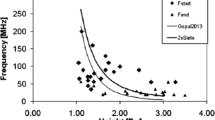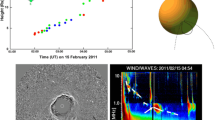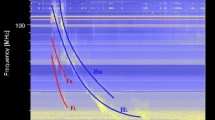Abstract
Studying the evolution of the source of a radio burst, which is recognized as a shock wave, is important for understanding its generation mechanism and predicting its hazards. Estimating the kinematics of radio-burst sources using electron-density models is not easy. In this article, the kinematics of the Type-II radio-burst source is estimated without using electron-density models by studying the density variation along the leading surface of the coronal mass ejections (CMEs) (hereafter ejecta) during Type-II radio-burst emission. This technique is valid for analyzing the Type-II radio-burst spectrum in metric and DH ranges, from which we can infer ejecta propagation from the corona into interplanetary space. It is found that the Type-II radio burst can be described by the Sedov–Taylor blast-wave equation by matching the calculated theoretical frequencies with that observed by the RAD1 and RAD2 receivers. The theoretical model showed a good fit with the observed spectra of Type-II radio bursts of different Type-II events. The analysis was consistent with the previous work regarding the conditions of the Sedov–Taylor equation and statistical studies of the density variation on the surface area of an interplanetary CME. The kinematics of a Type-II radio-burst source and the temporal variation of its energy are estimated during the Type-II radio-burst emission. The results of the two cases studied show that the energy of ejecta degraded by \(\approx 14\% \) of its initial energy at the beginning of metric Type-II radio emission on 16 March 2016, while the energy of ejecta degraded by \(\approx 86\%\) and \(\approx 20 \% \) for DH Type-II radio burst as recorded by RAD1 and RAD2 on 7 November 2004, respectively. The analysis shows that the radial speed of the blast wave is lower than its transversal speed along the surface of ejecta and extends to a small fraction of R⊙ from its source point on the ejecta. The magnetic-field strength of the ejecta and the ambient medium are estimated during the Type-II radio-burst emission. This study emphasizes that the emission of a blast wave from the reconnection sites within the ejecta is one of the processes that degrades the energy of ejecta during their propagation.






Similar content being viewed by others
References
Bothmer, V., Schwenn, R.: 1997, The structure and origin of magnetic clouds in the solar wind. Ann. Geophys.16, 1.
Cane, H.V., Sheeley, N.R., Howard, R.A.: 1987, Energetic interplanetary shocks, radio emission, and coronal mass ejections. J. Geophys. Res.92(A9), 9869.
Cliver, E.W., Nitta, N.V., Thompson, B.J., Zhang, J.: 2004, Coronal shocks of November 1997 revisited: The CME–type II timing problem. Solar Phys.225(1), 105. DOI . ADS .
Cook, N.B.: 2010, Analytical proof of the Taylor equation including Taylor’s constant \(S\gamma\) which previously required numerical integration, with applications. http://vixra.org/pdf/1003.0259v1.pdf .
Cowling, T.G.: 1953, The Solar System, vol. 1: The Sun. University of Chicago Press, Chicago, 533.
Draine, B.T., McKee, C.F.: 1993, Theory of interstellar shocks. Annu. Rev. Astron. Astrophys.31(1), 373.
Emslie, A.G., Kucharek, H., Dennis, B.R., Gopalswamy, N., Holman, G.D., Share, G.H., Vourlidas, A., Forbes, T.G., Gallagher, P.T., Mason, G.M., Metcalf, T.R., Mewaldt, R.A., Murphy, R.J., Schwartz, R.A., Zurbuchen, T.H.: 2004, Energy partition in two solar flare/CME events. J. Geophys. Res., Space Phys. 109(A10).
Emslie, A.G., Dennis, B.R., Shih, A.Y., Chamberlin, P.C., Mewaldt, R.A., Moore, C.S., Share, G.H., Vourlidas, A., Welsch, B.T.: 2012, Global energetics of thirty-eight large solar eruptive events. Astrophys. J.759(1), 71.
Fermo, R.L., Opher, M., Drake, J.F.: 2014, Magnetic reconnection in the interior of interplanetary coronal mass ejections. Phys. Rev. Lett.113(3), 031101.
Gopalswamy, N.: 2006, Coronal mass ejections and type II radio bursts. In: Gopalswamy, N., Mewaldt, R., Torsti, J. (eds.) Solar Eruptions and Energetic Particles, Geophys. Monograph. Ser.165, AGU, Washington, 207.
Gosling, J.T.: 1990, Coronal mass ejections and magnetic flux ropes in interplanetary space. In: Russell, C.T., Priest, E.R., Lee, L.C. (eds.) Physics of Magnetic Flux RopesMS-58, AGU, Washington, 343.
Kallenrode, M.B., Wibberenz, G., Kunow, H., Müller-Mellin, R., Stolpovskii, V., Kontor, N.: 1993, Multi-spacecraft observations of particle events and interplanetary shocks during November/December 1982. Solar Phys.147(2), 377. DOI . ADS .
Leblanc, Y., Dulk, G.A., Vourlidas, A., Bougeret, J.L.: 2001, Tracing shock waves from the corona to 1 AU: Type II radio emission and relationship with CMEs. J. Geophys. Res.106(A11), 25301.
Lengyel-Frey, D.: 1992, Location of the radio emitting regions of interplanetary shocks. J. Geophys. Res.97(A2), 1609.
Liu, Y., Luhmann, J.G., Bale, S.D., Lin, R.P.: 2009, Relationship between a coronal mass ejection driven shock and a coronal metric type II burst. Astrophys. J. Lett.69 1(2), L151.
Long, D.M., Baker, D., Williams, D.R., Carley, E.P., Gallagher, P.T., Zucca, P.: 2015, The energetics of a global shock wave in the low solar corona. Astrophys. J.799(2), 224.
Mann, G., Classen, T., Aurass, H.: 1995, Characteristics of coronal shock waves and solar type II radio bursts. Astron. Astrophys.295, 775.
Magdalenić, J., Vršnak, B., Pohjolainen, S., Temmer, M., Aurass, H., Lehtinen, N.J.: 2008, A flare generated shock during a coronal mass ejection on 24 December 1996. Solar Phys.253(1–2), 305. DOI . ADS .
Mahrous, A., Alielden, K., Vršnak, B., Youssef, M.: 2018, Type II solar radio burst band-splitting: 551 measure of coronal magnetic field strength. J. Atmos. Solar-Terr. Phys.172, 75.
Nelson, G.J., Melrose, D.B.: 1985, Type II bursts. In: MacLean, D.J., Labrum, N.R. (eds.) Solar Radiophysics: Studies of Emission from the Sun at Meter Wavelengths, Cambridge University Press, Cambridge, 333.
Pikel’ner, S.B., Gintsburg, M.A.: 1964, The mechanism of type II bursts of solar radio emission. Soviet Astron.7, 639.
Reiner, M.J., Kaiser, M.L., Fainberg, J., Bougeret, J.L., Stone, R.G.: 1998, On the origin of radio emissions associated with the January 6 – 11, 1997, CME. Geophys. Res. lett.25(14), 2493.
Rogers, M.H.: 1957, Analytic solutions for the blast-wave problem with an atmosphere of varying 561 density. Astrophys. J.125, 478.
Sedov, L.I.: 1946, Propagation of strong shock waves. J. Appl. Math. Mech.10(564), 241.
Smerd, S.F., Sheridan, K.V., Stewart, R.T.: 1975, Split-band structure in type II radio bursts from the 567 Sun. Astrophys. Lett.16, 23.
Taylor, G.I.: 1950, The formation of a blast wave by a very intense explosion, I: Theoretical discussion. Proc. Roy. Soc. London Ser. A, Math. Phys. Sci.201, 159. 1065.
Vourlidas, A., Howard, R.A., Esfandiari, E., Patsourakos, S., Yashiro, S., Michalek, G.: 2010, Comprehensive analysis of coronal mass ejection mass and energy properties over a full solar cycle. Astrophys. J.722, 1522.
Vršnak, B., Aurassć, H., Magdalenić, J., Gopalswamy, N.: 2001, Band-splitting of coronal and interplanetary type II bursts-I. Basic properties. Astron. Astrophys.377(1), 321.
Vršnak, B., Magdalenić, J., Aurass, H., Mann, G.: 2002, Band-splitting of coronal and interplanetary type II 577 bursts, II: Coronal magnetic field and Alfvén velocity. Astron. Astrophys.396(2), 673.
Westfold, K.C.: 1957, Magnetohydrodynamic shock waves in the solar corona, with applications to bursts 580 of radio-frequency radiation. Phil. Mag.2(23), 1287.
White, S.M.: 2007, Solar radio bursts and space weather. Asian J. Phys.16, 189.
Wild, J.P., McCready, L.L.: 1950, Observations of the spectrum of high-intensity solar radiation at 585 metre wavelengths, I: The apparatus and spectral types of solar burst observed. Austral. J. Chem.3(3), 387.
Acknowledgements
I am grateful to Ayman Mahrous, Helwan University in Egypt, Bojan Vršnak, Hvar Observatory in Croatia, and Alexander Nindos, University of Ioannina in Greece for their guidance and support. Thanks to the staff of the Learmonth solar radio spectrograph for their data and the NASA Staff of Wind/WAVES for their data.
Author information
Authors and Affiliations
Corresponding author
Additional information
Publisher’s Note
Springer Nature remains neutral with regard to jurisdictional claims in published maps and institutional affiliations.
Appendix: Evolution of Coronal and Interplanetary Shock Waves Inferred from Type II Radio Bursts
Appendix: Evolution of Coronal and Interplanetary Shock Waves Inferred from Type II Radio Bursts
Assume that the electron density [\(n _{\mathrm{e}}\)] along the front surface of the blast wave changes with radial distance [\(R\)] from the initial point of expansion, which is the center of the blast wave, as
where \(c _{1}\) and \(c _{2}\) are constants, and the exponents \(\alpha\) and \(H\) are constants. From the plasma frequency formula [\(f=a \sqrt{n_{\mathrm{e}}}\) ] the decrease of frequency with time is inferred from the decrease of the electron density with distance during the motion of the Type-II source. Substituting any three points (\(f_{1}, t_{1}\)), (\(f_{2}, t_{2}\)), (\(f_{3}, t_{3}\)) from a given fundamental emission of a Type-II spectrum into Equation 36 and using the relationship for the plasma frequency \(f^{2} =81 n_{\mathrm{e}} \), the general three equations will be
Substituting Equation 40 into Equation 38
Also, substituting Equation 41 into Equation 38 and repeating the steps in Equations 42 and 43, one gets
Let
The Sedov–Taylor equation describes the sudden release of a large amount of energy [\(E\)] into a background fluid of density \(\rho\), creating a strong spherical blast wave emanating from the point source; which in this article is the reconnection site on the ejecta. The Sedov–Taylor radius [\(R\)] of the blast wave is related to time [\(t\)] as
where \(E\) is the energy released in the explosion of the blast wave and \(\rho\) is the ambient density; \(S_{\gamma} \) is a function of the ratio of specific heats [\(\gamma\)]. Suppose that the blast wave occurs within a small fraction of a solar radius from the ejecta and the density does not change greatly. According to the Sedov–Taylor equation and Cook (2010) the ratio \({ R^{5}} / {\ t^{2}} \) of the blast wave is always a constant [\(A\)]. In other words, the radius is time dependent and could be written as \(R=A t^{\frac{2}{5}} \), where \(A= S_{\gamma} ( \frac{E}{\rho} )^{1/5} \) is constant. Thus, this gives
Using Equations 45, 46 and 48 and substituting into Equations 44a and 44b, respectively, one gets
Substituting Equation 48 into Equation 51, one gets
From Equation 52, the left-hand side equals the right-hand side only for \(H=\alpha\). Thus, Equations 40 and 41 could be written as
where \(\delta= ( \frac{R_{3}}{R_{1}} )^{-\alpha} = ( \frac{t_{3}}{t_{1}} )^{-\mu}\) and \(\mu= \frac{2}{5} \alpha\). Using Equations 48 in 53
Let \(J= \frac{\delta\ f_{1}^{2} - f_{3}^{2}}{81}\) and \(D= ( t_{3}^{-\mu} -\delta\ t_{1}^{-\mu} )^{-1}\). So, Equation 54 can be written as
Substituting Equation 55 into Equation 40
From Equation 55, Equation 56 becomes
taking into account that \(H=\alpha\) and \(R_{1}^{\alpha} = A^{\alpha} t_{1}^{\mu}\). Substituting Equation 57 into Equation 36
or
where \(n_{\mathrm{e} i} = n_{\mathrm{e} 1} R_{1}^{\alpha}\) is the initial electron density per unit area at radial distance \(R _{1}\) of the blast wave from its center.
Rights and permissions
About this article
Cite this article
Alielden, K. Evolution of Coronal and Interplanetary Shock Waves Inferred from a Radio Burst. Sol Phys 294, 159 (2019). https://doi.org/10.1007/s11207-019-1493-8
Received:
Accepted:
Published:
DOI: https://doi.org/10.1007/s11207-019-1493-8




